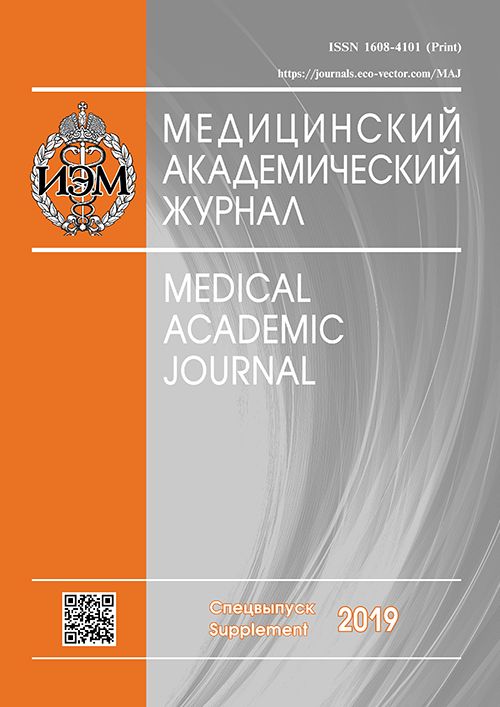Parameters of immunity and systemic inflammation in endogenous psychosis
- Authors: Malashenkova IK1,2, Ogurtsov DP1,2, Krynskiy SA1, Hailov NA1, Chekulaeva EI1, Didkovsky NA2, Mamoshina MV1, Ushakov VL1, Morozova AY.3, Zakharova NV4, Kostyuk GP4
-
Affiliations:
- NRC “Kurchatov Institute”, Moscow
- FSBI FCRC of Physical-Chemical Medicine FMBA of Russia, Moscow
- Federal Medical Research Centre for Psychiatry and Narcology, Moscow
- Psychiatric Clinical Hospital No. 1 named after N.A. Alekseev, Moscow
- Issue: Vol 19, No 1S (2019)
- Pages: 70-72
- Section: Articles
- Published: 15.12.2019
- URL: https://journals.eco-vector.com/MAJ/article/view/19330
- ID: 19330
Cite item
Full Text
Abstract
Keywords
Full Text
Schizophrenia is a multifactorial polymorphic mental disorder with characteristic disorders of thinking and perception [1]. Genetic predisposition and congenital pathology of the brain due to intrauterine hypoxia, infectious diseases and maternal starvation, as well as exogenous factors including social, toxic, infectious (intracellular parasitic infections, viral infections and a number of others) play an important role in the development of SCI [2]. The etiology and pathogenesis are not sufficiently studied, and experimental models of SCI are not adequate enough. It is believed that dysfunction of neurotransmitter interactions affecting dopamine, glutamate, serotoninergic and other systems and neurotrophin deficiency play an important role in the pathogenesis of SCI. There is strong epidemiological, genetic and clinical evidence of immune disorders in schizophrenia. Exacerbations of the disease are accompanied by a high content of a number of proinflammatory cytokines and other markers of systemic inflammation in the CSF and serum, activation of Th2 link of adaptive immunity [3]. We examined 31 patients diagnosed with schizophrenia, after 3-4 weeks of therapy. The control group consisted of 16 people without cognitive impairment. Indicators of healthy volunteers we obtained earlier were also used for reference. The levels of systemic inflammation markers (circulating immune complexes (CIC), C-reactive protein, cortisol), of key cytokines (IL-1β, TNFa, IL-6, IL-8, IL-10, IFNy, soluble receptor of IL-1β - IL-1RA, IL-12 (P40)) and neurotrophic factors (NT) BDNF, NGFβ and NT-4 were assessed by ELISA. Phenotyping of lymphocytes (CD3, CD45, CD4, CD8, CD16, CD56, CD20, HLA-DR, CD38, CD127) was performed by multicolored flow cytometry. A significant increase in levels of IgM, C-reactive protein and cortisol in the blood of patients with schizophrenia compared with healthy groups was found (Table 1). Most patients with schizophrenia showed an increase in the content of proinflammatory cytokines-IL-8, IL-6 and IFNy (Figure 1). The greatest increase in the levels of systemic inflammation and cytokines was found in patients with the first psychotic episode. The content of NT was highly variable, but the level of NT-4 and nerve growth factor β (NGFß) in most patients was associated with the content of IL-6. At its increased level, the content of NT-4 and Ngfß increased, at the normal level of IL-6 it was also within normal limits. More than half of the patients with SCI had normal BDNF levels. At its low level, Ig levelswere normal, but levels of CIC, cortisol, IL-8, IL-6 and IL-10 were significantly increased. Also, in the clinical picture in patients with low BDNF symptoms of delirium prevailed, mild hallucinatory syndrome persisted on the background of therapy only in 2 out of 7 people. In cases of normal or elevated BDNF, hallucinatory syndrome was pronounced and prolonged. Conclusion. Neuroinflammation is considered to be one of the links in the pathogenesis of SCI. According to the literature, antipsychotic drugs have anti-inflammatory and immunomodulatory effects. However, we have found signs of systemic inflammation, activation and dysfunction of the immune system in patients with schizophrenia, despite the therapy. Taking into account the hypotheses of the pathogenesis of schizophrenia, it can be assumed that the preservation of immune disorders and systemic inflammation can participate in the progression of the disease through various ways of neuroimmune interactions. Further studies of the trigger mechanisms of chronic immune activation are needed. This work was supported in part by the National Research Center “Kurchatov institute” (grant #1604).About the authors
I K Malashenkova
NRC “Kurchatov Institute”, Moscow; FSBI FCRC of Physical-Chemical Medicine FMBA of Russia, Moscow
D P Ogurtsov
NRC “Kurchatov Institute”, Moscow; FSBI FCRC of Physical-Chemical Medicine FMBA of Russia, Moscow
S A Krynskiy
NRC “Kurchatov Institute”, Moscow
N A Hailov
NRC “Kurchatov Institute”, Moscow
E I Chekulaeva
NRC “Kurchatov Institute”, Moscow
N A Didkovsky
FSBI FCRC of Physical-Chemical Medicine FMBA of Russia, Moscow
M V Mamoshina
NRC “Kurchatov Institute”, Moscow
V L Ushakov
NRC “Kurchatov Institute”, Moscow
A Yu Morozova
Federal Medical Research Centre for Psychiatry and Narcology, Moscow
N V Zakharova
Psychiatric Clinical Hospital No. 1 named after N.A. Alekseev, Moscow
G P Kostyuk
Psychiatric Clinical Hospital No. 1 named after N.A. Alekseev, Moscow
References
- Dickinson D, Ramsey ME, Gold JM. Overlooking the obvious: a meta-analytic comparison of digit symbol coding tasks and other cognitive measures in schizophrenia. Arch Gen Psychiatry. 2007;64(5):532-542.
- Owen MJ, O’Donovan MC. Schizophrenia and the neurodevelopmental continuum: evidence from genomics. World Psychiatry. 2017;16(3):227-235.
- Goldsmith DR, Rapaport MH, Miller BJ. A meta-analysis of blood cytokine network alterations in psychiatric patients: comparisons between schizophrenia, bipolar disorder and depression. Mol Psychiatry. 2016;21(12):1696-1709.
Supplementary files







